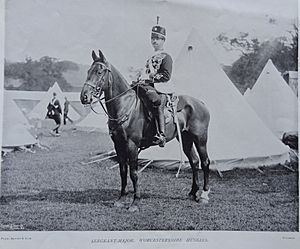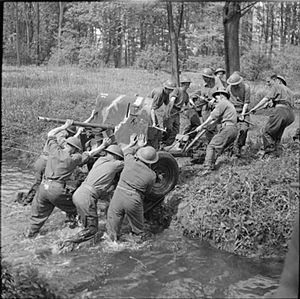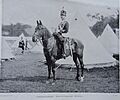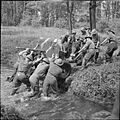Queen's Own Worcestershire Hussars facts for kids
Quick facts for kids Queen's Own Worcestershire Hussars |
|
|---|---|
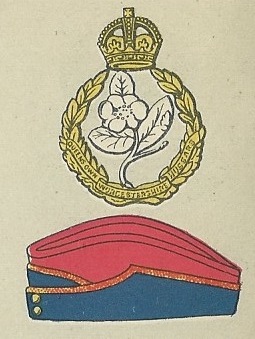
Badge and service cap as worn at the outbreak of World War II
|
|
| Active | 1794–Present |
| Country | |
| Branch | |
| Type | Yeomanry |
| Size | Regiment [World Wars] Two Squadrons [Present day] |
| Part of | Royal Armoured Corps Royal Signals |
| Battle honours | World War II No battle honours were awarded. It is tradition within artillery units that the Regiment's guns represent its colours and battle honours. |
The Queen's Own Worcestershire Hussars was a special group of soldiers in the British Army. They were part of the Yeomanry, which were volunteer cavalry units. This group first started in 1794. They fought in the Second Boer War and World War I as soldiers on horseback. Later, for World War II, they changed to an anti-tank unit, using guns to stop enemy tanks. In 1956, they joined with another group, the Warwickshire Yeomanry. Today, their history is carried on by a part of The Royal Yeomanry.
Contents
- How the Queen's Own Worcestershire Hussars Started
- Serving During Peacetime and Unrest
- The 19th Century: Changes and New Roles
- The Imperial Yeomanry and the Boer War
- The Queen's Own Worcestershire Hussars in World War I
- Between the World Wars: A New Role
- The Queen's Own Worcestershire Hussars in World War II
- After the Wars: Changes and Legacy
- Regimental History and Traditions
- More About Yeomanry Units
- Images for kids
How the Queen's Own Worcestershire Hussars Started
The Queen's Own Worcestershire Hussars began in 1794. Back then, they were called the Worcestershire Yeomanry. King George III was the king, and William Pitt the Younger was the prime minister of Great Britain. Across the English Channel, France had a huge army.
The Prime Minister suggested that counties should form volunteer cavalry groups. These groups, called the Yeomanry, would help defend the country. They could fight against invaders or help control public order.
Worcestershire quickly agreed to this idea. In April 1794, people met in Worcester to raise money. They wanted to create a new group of yeomanry cavalry. By August, they decided to form two troops, each with 56 men.
The first troop was called the Worcester Troop of Gentlemen and Yeomen. They had their first parade in Worcester in October 1794. They started training at Powick. A second troop was formed in 1796. The leader, Hon. John Somers Cocks, became a major. This meant he now commanded what was called a squadron.
More volunteer cavalry troops were allowed to form in 1798. These groups could only operate within their own county.
Serving During Peacetime and Unrest
After 1802, the threat of a French invasion seemed to go away. The King praised the Worcestershire Yeomanry for helping defend the country. But the peace did not last long, and fighting started again in 1803. By the end of that year, the Worcester Cavalry had three troops. Their commander, Major Somers Cocks, became a lieutenant-colonel.
The Yeomanry trained with regular army cavalry units when they could. In 1810, riots broke out in Worcester. The Yeomanry were called to help the local militia stop the trouble.
In 1811, the independent volunteer cavalry groups joined the Yeomanry. They had to train for 12 days a year. They received the same pay as regular cavalry soldiers during their training.
The 19th Century: Changes and New Roles
After the Battle of Waterloo in 1815, many volunteer groups were disbanded. But most Yeomanry regiments, including the Worcestershire, chose to keep serving.
In 1818, the Worcestershire Yeomanry were called to stop a disturbance in Worcester. Rioters were tearing down buildings on common land. The Yeomanry faced a shower of stones but managed to retreat safely. The rioters then left peacefully. The regiment also helped during unrest among miners in 1822.
The government stopped supporting the Yeomanry after 1827. Most regiments, including the Worcestershires, were disbanded. However, more public disorder led to many regiments being reformed in 1831. The Worcestershire magistrates decided to bring their regiment back. The government approved this on April 29, 1831.
The regiment had ten troops, each with 50 men. They also had two small cannons.
In their first year, the regiment helped with riots in several towns. They also dealt with miners' riots in Dudley. In 1832, they added a new squadron of 100 men in Dudley. This squadron rode only grey horses and was known as the 'Grey Squadron'.
In November 1832, Princess Victoria visited the Earl of Plymouth. The regiment provided her escort. After she became Queen Victoria in 1837, she gave the regiment the title 'Queen's Own'. From then on, they were called the Queen's Own Regiment of Worcestershire Yeomanry.
The regiment continued to help the police. They were called out during a boat hauliers' strike in 1832. They also helped during the Chartist riots in Birmingham in 1839. And they served for several months during miners' riots in 1842.
In 1871, the Yeomanry came under the control of the Secretary of State for War. The regiment was reorganized into eight troops. They also changed their uniform to a Hussar style. In 1887, during Queen Victoria's Golden Jubilee, their name changed to Queen's Own Worcestershire Hussars.
By 1893, the Yeomanry were organized into squadrons. The Worcestershire Hussars had four squadrons: A at Dudley, B at Bromsgrove, C at Malvern, and D at Worcester.
The Imperial Yeomanry and the Boer War
In 1899, the regiment was called to serve in the Second Boer War in South Africa. The British Army needed more cavalry. So, the English Yeomanry Regiments were asked for volunteers. The Worcestershire Hussars' leader, Lord Windsor, asked for volunteers. He chose 129 men from over 3,000 who offered to go.
The Worcestershire group became the 16th Company of the 5th Battalion, Imperial Yeomanry Cavalry. Their job was to protect railways and capture enemy supplies. They used Martini–Henry carbines and small guns. These guns were actually owned and paid for by Lord Plymouth himself.
The Countess of Dudley gave each soldier a silk pear blossom. This was the symbol of Worcestershire. It was a reminder of home. When the soldiers returned in 1903, the Countess gave the regiment a special pear blossom. It was made by Fabergé from gold, diamond, crystal, and jade. The unit still brings it out for special dinners.
More Worcestershire soldiers went to South Africa in 1901. The war ended in June 1902. The regiment lost 16 non-commissioned officers (NCOs) killed and 20 wounded.
The Imperial Yeomanry were trained to fight on horseback and on foot. This was a success. In 1901, all Yeomanry regiments became Imperial Yeomanry. The Worcestershire regiment was called the Worcestershire Imperial Yeomanry (The Queen's Own Worcestershire Hussars). The "Imperial" part was dropped in 1908. The regiment was based in Worcester at this time.
The Queen's Own Worcestershire Hussars in World War I
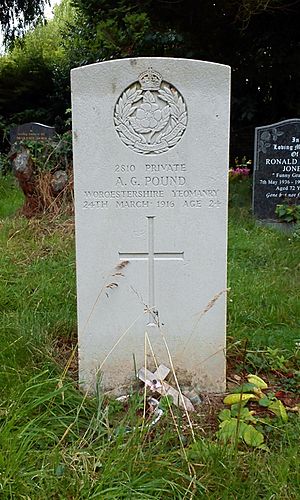
When World War I started in August 1914, many members of the Yeomanry volunteered to serve overseas. So, the units were split into two groups. The 1st Line units could serve abroad. The 2nd Line units stayed home. A 3rd Line was formed later to train new soldiers.
Fighting in Gallipoli and Egypt
The 1st Line Queen's Own Worcestershire Hussars were led by the Earl of Dudley. He believed another European war was coming. So, he made sure the regiment was well-trained in shooting.
In 1915, the Worcestershires were sent to Egypt. In August, they learned they would fight as infantry, meaning on foot. They went to Suvla Bay and joined the Gallipoli campaign. They supported other British and Anzac soldiers. They tried to break through Turkish defenses on the hills. But the defenses were too strong. The Gallipoli campaign ended in January 1916.
The regiment then returned to Egypt. New soldiers replaced those lost in battle. Their job was to protect the eastern side of the Suez Canal. They dug wells and sent out patrols to find Turkish forces.
On April 23, 1916, 3,000 Turkish troops attacked a small British group at Oghratine. This group included soldiers from the Worcestershire Yeomanry. The Turks had 12 machine guns. The defenders fought hard but were forced back. Many soldiers were killed or wounded.
The Turks then attacked Qatia. Qatia fell, and almost all the Yeomanry officers were lost. Only one major and about half a squadron managed to escape. Anzac troops later saw how fierce the battle had been. They praised the bravery of the defenders. In these fights, 9 officers and 102 NCOs and men of the regiment were killed. Many more were wounded.
In August 1916, a combined regiment, including the Worcestershire Yeomanry, was formed. They worked with Anzac regiments. Their mission was to push back 48,000 Turks from Romani. Romani was an important watering hole and a Turkish base. After a tough battle, the Turks had to retreat. Many guns were captured.
The Last Cavalry Charge
The Turkish army regrouped at Gaza. The British advance stopped until General Edmund Allenby arrived. He reorganized the army. This allowed them to attack Turkish positions at Beersheba. The Turks were surprised and had to pull back.
During the chase, the Worcestershire Yeomanry and the Warwickshire Yeomanry made history. They took part in the last cavalry charge on guns in British military history. This happened at Huj in November 1917. Under Colonel Hugh Cheape, the cavalry charged a group of Turkish guns. This action helped the 60th London Division, who were stuck under Turkish fire. The charge forced the Turks to retreat, and the guns were captured.
The Yeomanry suffered heavy losses. Two out of nine officers were killed, and four were wounded. Out of 96 NCOs and men, 17 were killed and 35 wounded.
Home Service During the War
The 2nd Line regiment was formed in Worcester in September 1914. They moved around England, training for home defense. In July 1916, they became a cyclist unit. They were stationed at Tunbridge Wells. Later, they joined with another regiment to form the 12th (Gloucestershire and Worcestershire) Yeomanry Cyclist Regiment. In March 1917, they went back to being the 2/1st Queen's Own Worcestershire Hussars. Around April 1918, the regiment moved to Dublin, Ireland, where they stayed until the war ended.
The 3rd Line regiment was formed in 1915. They trained new soldiers to replace those fighting in the 1st and 2nd Lines.
Between the World Wars: A New Role
The regiment returned from Palestine in 1919. They were not at full strength but quickly reformed. After the war, it was clear that cavalry (soldiers on horseback) were no longer as useful. In 1922, the Worcestershire Hussars became two horse-drawn batteries in the Royal Field Artillery (RFA). They were called 397 at Worcester and 398 at King's Heath, Birmingham.
In 1924, the RFA became part of the Royal Artillery (RA). The unit was renamed the 'Army Field Brigade, RA'. Their horses were replaced by artillery tractors.
As Britain prepared for World War II, the 100th Field Brigade changed again. On November 28, 1938, they became an anti-tank unit. They were called the 53rd (Worcestershire and Oxfordshire Yeomanry) Anti-Tank Regiment, RA. Their old 18-pounder guns were replaced with smaller, faster 2-pounder guns.
In February 1939, the 53rd Anti-Tank Regiment split. The Worcestershire Yeomanry batteries stayed with the 53rd. They grew to four batteries: 209, 210, 211, and 212.
The Queen's Own Worcestershire Hussars in World War II
Fighting in France
The regiment was part of the 48th (South Midland) Infantry Division. In January 1940, they went to France to join the British Expeditionary Force (BEF). They were on the border between France and Belgium.
On May 10, 1940, the German Army attacked. The BEF moved forward to positions on the River Dyle. The BEF commander, Lord Gort, knew they might have to retreat to the coast. He used the 48th Division to cover 28 miles of the La Bassee Canal.
Their job was to protect the BEF's western side. They held strongpoints like canal crossings. The 210 and 211 Batteries caused heavy losses for the enemy. They supported the 2nd Battalion, Royal Warwickshire Regiment, who were holding the town of Wormhoudt. Some of these soldiers were later involved in the Wormhoudt massacre.
The regiment received orders to destroy their guns and vehicles. They were told to go to Dunkirk. Near Oost-Cappell, the 212 Battery defended a crossroads against German tanks. They destroyed some tanks before being forced to leave. Each battery was ordered to escape to Dunkirk. Only five officers and 284 men of the regiment were evacuated from the beaches of Dunkirk in Operation Dynamo. However, the regiment had destroyed more enemy tanks than any other anti-tank regiment of the BEF.
Becoming an Airborne Unit
After returning to England, the regiment helped form a new anti-tank battery in July 1941. In October 1941, the regiment joined the 42nd (East Lancashire) Infantry Division. This division was changing into an armored division.
In October 1943, the 42nd Armoured Division was broken up. The regiment then moved to the 6th Airborne Division. On November 3, they became a light field regiment. They were called the 53rd (Worcestershire Yeomanry) Air Landing Light Regiment, RA. This meant they were now part of the British Army's airborne forces.
D-Day and Normandy
Because there were not enough gliders, only the 211 Battery took part in the British airborne assault on D-Day, June 6, 1944. They were part of the 6th Airborne Division. Their mission was to capture and hold the wooded area behind Caen. This area would see very heavy fighting during the Battle for Caen.
The 211 Battery landed near Caen in 27 gliders on June 6. The regiment's other batteries, 210 and 212, arrived in Normandy by sea on June 14. They joined up with 211 the next day. The full regiment started fighting on June 15. The regiment set up observation posts. They provided information for the Parachute and Commando Brigades to target German mortar positions. By August 16, reports said the Germans were pulling back.
Major-General Richard Nelson Gale, the commander of the 6th Airborne Division, ordered his troops to keep pressure on the retreating Germans. They followed the coastal route towards the Seine in Operation Paddle. Progress was slow, but the regiment reached Honfleur on August 27. Then, they returned to England to rest and prepare for future airborne operations.
On December 20, 1944, the regiment was ordered back to France. By December 26, they were fighting near Dinant. They supported the 6th Airlanding Brigade. This was during the Battle of the Bulge, when Americans and British defended against a German attack. The regiment's 210 Battery claimed to be the first to fire shells over the border into German territory.
Operation Varsity and the End of the War
In March 1945, the plan for Operation Varsity was to drop two Airborne divisions (the British 6th and US 17th) behind enemy lines. This included the regiment. Their goal was to cut off the industrial Ruhr area and disrupt German defenses. On March 24, 78 gliders took off from England. They made a successful attack, establishing positions on the eastern bank of the Rhine.
The first guns were firing within 10 minutes of the gliders landing. By evening, all the division's goals were met. But 2 Battery Commanders and 20 other soldiers were killed. Eight officers and 59 men were missing or captured. The advance continued. Six weeks later, they reached the Baltic coast.
The regiment fought in and captured towns like Greven, Lengerich, Osnabrück, Minden, and Lahder. They met strong German resistance near Celle on April 15. German self-propelled guns caused problems for the 6th Airborne. But the regiment heavily shelled them, and the Germans were outflanked. On April 30, the regiment met the Russian Army at Wismar on the Baltic Coast.
Post-War Service in Palestine
The regiment returned to England by May 23, 1945. In September, they were ordered to Palestine. Their job was to help keep peace and security. They retrained as infantry to act as a police force. They controlled traffic and searched roads. Their biggest operation was searching Tel Aviv for hidden weapons and suspicious people.
After the Wars: Changes and Legacy
The regiment changed its name to the 33rd Airborne Light Regiment (Worcestershire Yeomanry), RA. In January 1948, they moved to Germany.
However, the Worcestershire Yeomanry had already been reformed in 1947 in Kidderminster. They were now the 300th (Worcestershire Yeomanry) Anti-Tank Regiment, RA. They used six-pounder and later 17-pounder anti-tank guns.
In 1950, the regiment became cavalry again. They were called the Queen's Own Worcestershire Hussars. They were equipped with armored cars and joined the Royal Armoured Corps.
In 1956, the government decided to reduce the size of the Territorial Army. In November 1956, it was announced that the Warwickshire Yeomanry and The Queen's Own Worcestershire Hussars would join together. The new regiment became the Queen's Own Warwickshire and Worcestershire Yeomanry in 1957. Queen Elizabeth II agreed to be the Honorary Colonel of the new regiment. This was a special honor, as they were the only regiment in the army with the Queen as their Honorary Colonel.
Regimental History and Traditions
Regimental Museum
The Worcester Soldier galleries are part of the Worcester City Art Gallery & Museum. They tell the story of the Worcestershire Regiment and the Queen's Own Worcestershire Hussars.
Uniforms and Badges
When the "Worcestershire Troop of Gentlemen and Yeomen" formed in 1794, they wore red jackets with dark blue and silver. They had white or buff trousers. Their helmet was like the Tarleton helmet worn by regular light cavalry.
When they reformed in 1831, they wore a red and white Light Dragoon uniform. This included a plumed shako (a tall, stiff cap). From 1850 to 1870, they wore a Heavy Dragoon helmet.
In 1871, they switched to a dark blue hussar uniform. It had a lot of silver or white braiding. They also wore fur busbies (tall, furry hats) like regular hussars. These had red plumes and bags. Simpler blue uniforms were used for training.
Around 1902-03, a khaki "lancer" style uniform was introduced. It had scarlet facings. They also wore a wide-brimmed slouch hat with a scarlet band and plume. This modern uniform was not popular. By 1908, the dark blue, silver, or white full dress uniform was brought back.
After 1907, they mostly wore the plain khaki service uniform of the regular cavalry. After 1914, this replaced the colorful full dress for almost all occasions. After 1938, they wore standard British Army uniforms. But some features, like the historic blue and scarlet colors, remained. You can see this in the field service caps from World War II (like the one shown at the start of this article).
More About Yeomanry Units
- Imperial Yeomanry
- List of Yeomanry Regiments 1908
- Yeomanry
- Yeomanry order of precedence
- British yeomanry during the First World War
- Second line yeomanry regiments of the British Army
- List of British Army Yeomanry Regiments converted to Royal Artillery
Images for kids


